Yesterday's post included a set of photos of a boy playing around under the swings as a classmate was swinging. It wasn't a particularly risky activity in my view. I mean, I was standing right there, taking pictures, discussing it with him, and it didn't set off any alarm bells for me in the moment, although after the fact, while going through them, it occurred to me that it was something that would be scuttled in other settings. My lack of concern probably stems from the fact that it's far from the first time this sort of thing has happened:
In fact, I think what caught my attention about it was that it was the first time I'd seen a kid do more than just lie there giggling. Of course, many schools have removed their swings altogether, so maybe the very existence of swings is shocking to some.
I imagine that in some dystopian future we'll become notorious for being the
only school left with a swing set, let alone for not having a set of rules about how the kids can use them. That's because, in our five years with swings, since our move to the
Center of the Universe, we've not found a need for safety rules, because the kids, the ones that live in the world outside our catastrophic imaginations, haven't shown a particular propensity to hurt themselves or one another.
Oh sure they get hurt like all kids do, like all people, but most of the injuries don't come from what people call "risky play," but rather from day-to-day activities, things you would think children had mastered. For instance, the worst injury we've seen during my 15 year tenure at Woodland Park came when a boy fell on his chin while walking on a flat, dry, linoleum floor. He needed a couple stitches. Another boy wound up with stitches when he fell while walking in the sandpit.

Increasingly, I find myself bristling when I hear folks talk about "risky play," even when it's framed positively. From my experience, this sort of play is objectively
not risky, in the sense that those activities like swinging or climbing or playing with long sticks, those things that tend to wear the label of "risky" are more properly viewed as
"safety play," because that's exactly what the kids are doing: practicing keeping themselves and others safe. It's almost as if they are engaging in
their own, self-correcting safety drills.
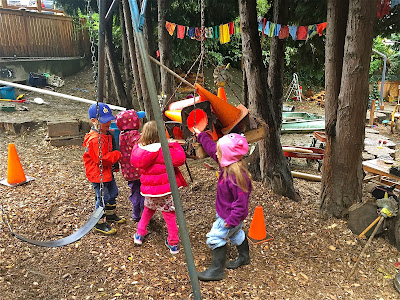
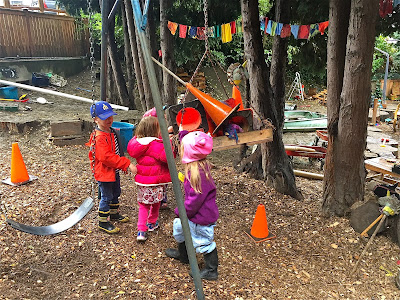
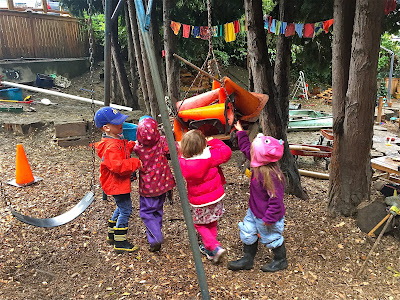

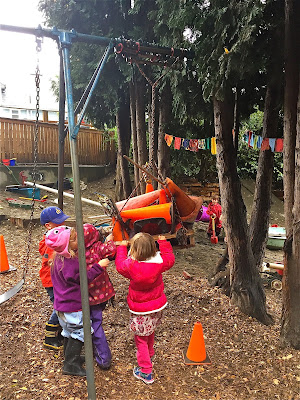
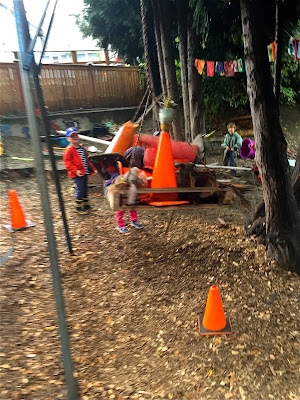


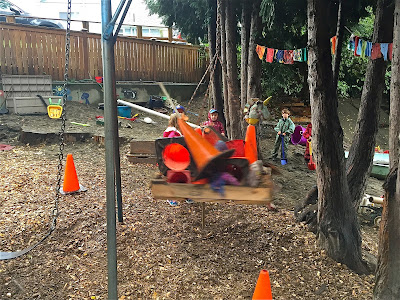
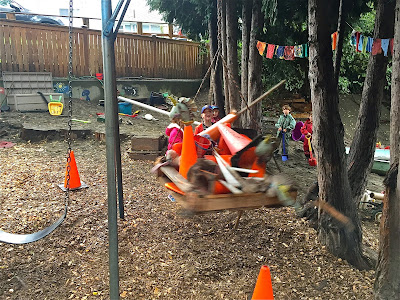

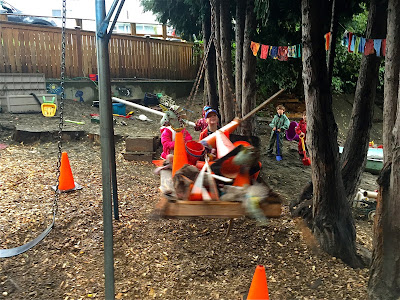

When a group of four and five year olds load up
the pallet swing with junk, then work together to wind it up higher and higher, then, on the count of three, let it go, ducking away as they do it, creating distance between themselves and this rapidly spinning flat of wood that they've learned is libel to release it's contents in random directions, they are practicing keeping themselves and others safe. They don't need adults there telling them to "be careful" or to impose rules based on our fears because those things are so manifestly necessary to this sort of thing that they are an unspoken part of the play.
When children pick up long sticks and start employing them as light sabers, swinging them at one another, they are practicing keeping themselves and others safe. The safety is built into it.
When preschoolers are provided with carving tools and a pumpkin they automatically include their own safety and that of others into their play. Adult warnings to "be careful" are redundant at best and, at worst, become focal points for rebellion (which, in turn, can lead to truly risky behavior) or a sense that the world is full of unperceived dangers that only the all-knowing adults can see (which, in turn, can lead to the sort of unspecified anxiety we see so much of these days). Every time we say "be careful" we express, quite clearly, our lack of faith in our children's judgement, which too often becomes the foundation of self-doubt.
The truth is that they already are being careful. The instinct for self-preservation is quite strong in humans. It's a pity that we feel we must teach them to live within our catastrophic imaginations.
1 comment:
"Increasingly, I find myself bristling when I hear folks talk about "risky play," even when it's framed positively. From my experience, this sort of play is objectively not risky, in the sense that those activities like swinging or climbing or playing with long sticks, those things that tend to wear the label of "risky" are more properly viewed as "safety play," because that's exactly what the kids are doing: practicing keeping themselves and others safe. It's almost as if they are engaging in their own, self-correcting safety drills."
I've recently been trying, futilely, to promote the term 'challenging' rather than 'risky'. You'll appreciate that the the c-word has a double meaning, children are challenging themselves, and adult frettiness is being challenged.
They ARE engaging in their own self correcting activity. I teach playworkers about the 'edge-of-chaos' I've taken to using hyphens because people confuse it with 'nearly chaos'. It's not: edge-of-chaos is an entirely different thing. When I used to do mountain biking it was about finding my personal edge of chaos, my 'flow state'. We tune to it. Too much and it's scary, not enough and its boring.
Edge-of-chaos exists in all complex systems, like a group of kids on a playground for example, both as a grip e and for each child.
I loved "catastrophic imaginations." Spot on.
Post a Comment